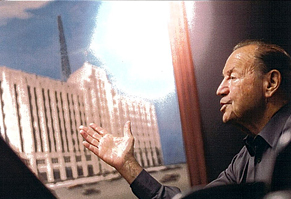Mr. Buy-and-hold
ADCO chief's plans would give Dworman big S.F. impact -- again

San Francisco Business Times
By: J.K. Dineen
Photo: Douglas Zimmerman
Developer Alvin Dworman was preparing to fly from
Los Angeles to London in 1960 when he received a urgent message from an associate in New York.
"I get this call saying you have to come to San Francisco right away, you can get the Western Addition. I said, 'What the hell is that?' I don't think I had ever been in San Francisco before," recalled Dworman.
Dworman, who had already taken on a large-scale redevelopment partnership in New York decided to make the trip. And it turned out to be the beginning of one of Dworman's most important, and longest-lasting, business ventures.
Nearly 50 years after the San Francisco Redevelopment Agency tapped Dworman to redevelop a series of parcels atop what was to become Cathedral Hill, the ADCO Group chairman is still the major landowner in that neighborhood and finds himself smack in the middle of two of the city's most high-profile developments.
On Cathedral Hill, at 1330 Gough St. across from the cathedral Dworman helped create, he is proposing an elliptical white curtain-wall 38-story condo tower being designed by Skidmore Owings and Merrill. In the burgeoning Mid-Market neighborhood, meanwhile, Dworman has embarked on repositioning his massive art deco San Francisco Mart, a landmark furniture wholesale showroom complex being reinvented as a mixed-use campus with 1 million square feet of office space and up to 250,000 square feet of retail.
At a time when private equity groups and pension funds buy and sell office and residential towers at the drop of a hat, ADCO Group is a throwback, a rare investor that holds onto its properties. Former San Francisco Mayor Willie Brown, who has known Dworman for more than 30 years, said patience is one of Dworman's defining characteristics.
"Alvin doesn't sell, he buys," said Brown. "Just think about 1330 Gough St. He has had that the entire time. Just think about how valuable that property has become without any great capital additions. I think that is how he has built his wealth, not by selling and pulling money out but by owning and allowing it to grow."
Changes in the works
In a rare interview, the New York-based Dworman said it's coincidence that he happens to be making major changes simultaneously to two of his more prominent San Francisco properties, one which he has owned for 39 years and one for more than 40.
On Cathedral Hill, the development site at 1330 Gough was protected from development for 40 years under the expiring use agreement with Housing and Urban Development. At the San Francisco Mart, Dworman said he is reacting to a strengthening Mid-Market residential neighborhood and the fact that a new competing furniture wholesale design showroom -- 3 million square feet and publicly subsidized -- has been built in Las Vegas. Dworman said he is "not being smart, I'm reacting to bad things."
"I'm reacting to the fact that the furniture mart was a business going downhill," he said. "It's learning that when a confrontation comes, how do you take advantage of it?"
The more he looked at changes in the Civic Center and Mid-Market area, including the new Federal Building and 5,000 units of housing in the pipeline, the more he felt he was sitting on a "gold mine."
ADCO is proposing to cover Stevenson Alley, which runs between the mart's two buildings, with a glass dome, creating a place for residents to socialize and eat. Dworman is investing $35 million in improvements.
"We're between Hayes Valley and the Fifth Street stuff. In my opinion this neighborhood is it. It's Civic Center. It's the theater district. And it's a dead place at night. This street has got to come alive. And that is what I think we can do. We're going to make it a building that is going to be fabulous forever."
Humble roots
Dworman grew up in Coney Island, where his immigrant father worked concessions on the boardwalk. A Golden Gloves boxer at 16, Dworman was an all-city football player and sprinter at Abraham Lincoln High School in Brooklyn.
After high school in 1944, he enrolled in an Army specialized training program and shipped to London. There he met Charlie Torem, a Harvard-trained, Paris-based attorney with Coudert Brothers, who would become an important mentor. It was Torem who pushed Dworman toward law school and helped him get into New York Law School.
"He said, 'You're a difficult guy, you question everything and you don't listen -- you should be a lawyer," recalled Dworman.
While he was in law school at night, Dworman had his first taste of deal making. He rented a parking lot in Queens to put on flea markets and a farmers market. He was also playing semi-pro football for $50 a week when he met Jackie Robinson through a teammate. Robinson had just signed a $29,000 contract with the Brooklyn Dodgers. Dworman had an idea.
"I said, 'I'm going to start a barnstorming tour for you. I checked your contract out and it said you're allowed to play 30 days in the off season. We'll go to play in New Orleans and Baton Rouge one day and Mobile and Birmingham the next.' I was still going to law school, so I paid some guy to sit in class for me during the tour."
The tour, which lasted for four years, generated profits of $90,000 annually, which were divided equally between Dworman, Robinson, and a promoter.
"We were running full wherever we went," said Dworman, who later developed housing with Robinson in Harlem. Meanwhile, Dworman finished law school and, after a brief 90-day stint as a lawyer, figured out a way to carve out a lucrative niche as a liaison between mortgage brokerages and banks looking for home loans to service.

